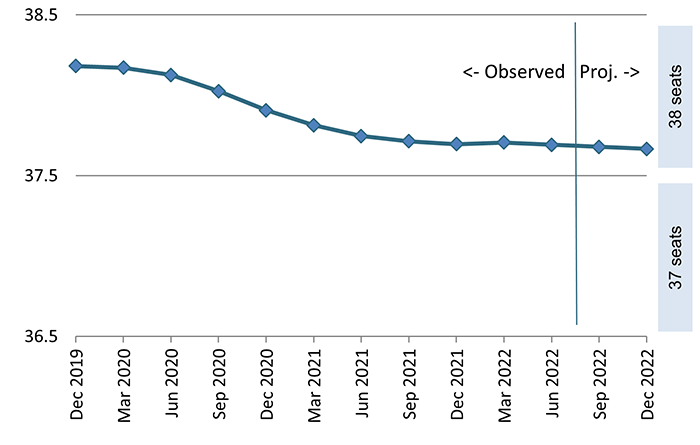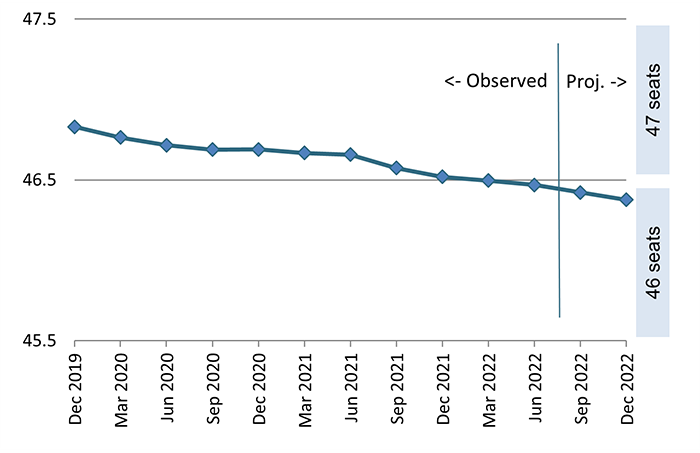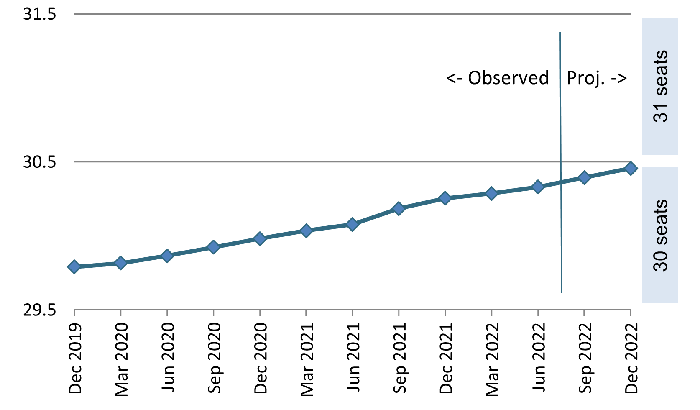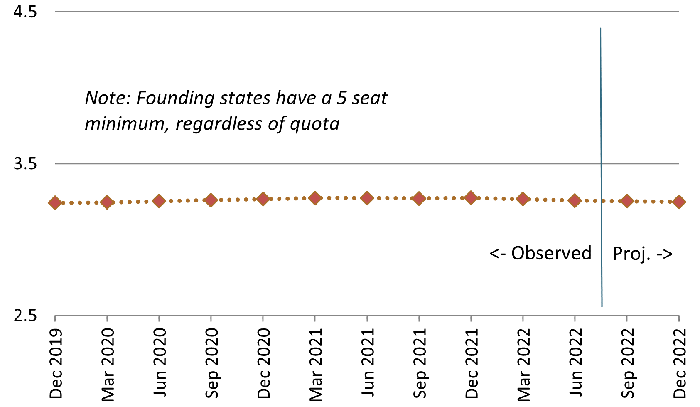Updated 9 January 2023
PDF Version [387KB]
Christopher Giuliano
Stats and Mapping
Executive
summary
This is the third issue of this paper, replacing the previous
versions published on 14 November 2022 and 25 August 2022. Tables, charts and
text have been updated as per the latest quarterly release of ABS population
data. The Parliamentary Library will re-issue this paper after each of the next
2 quarters.
The periodic redrawing of federal electoral boundaries is
required by law to maintain electoral divisions (also known as electorates or
seats) of roughly equal enrolment size within a state or territory. Redrawing
of boundaries is known as a redistribution.
Redistributions take place every 7 years or can be brought
about by the ‘representation entitlement trigger’, which determines the number
of members of the House of Representatives a state or territory is entitled to,
based on its share of the population.[1]
During the life of the 47th Parliament, redistributions are
expected to occur in Western Australia, Victoria, New South Wales, and the
Northern Territory.
Population projections based on the 2021 Australian Bureau of
Statistics Census of Population and Housing (the Census) suggest that Western
Australia may gain a seat and New South Wales and Victoria will both lose one.
There’s a remote chance that Queensland gains a seat, but since
this is neither ‘expected’ nor ‘likely’ this outcome has not been included when
either of these terms are used in this paper.
The scheduled 7-year redistribution for the Northern Territory
should go ahead during the 47th Parliament, but scheduled redistributions
for Queensland, Tasmania, Australian Capital Territory and South Australia will
be deferred until the next parliament, as they fall too late in the
parliamentary term. No changes in seat numbers are expected to occur in these
states and territories.
Based on the most likely entitlement outcomes, there should be
one fewer seat at the next election—150 rather than 151 seats, the same number
as there were from 2001 to 2016.
Caveats
The net corrections to jurisdictions’ populations based on the
Census have been the largest since at least 1991 and will cause changes in
entitlement to Western Australia and Victoria, and quite likely to New South
Wales.[2]
These corrections have been associated with the impact of COVID-19, driven by
factors such as people updating their home addresses with Medicare when they
get vaccinated for COVID-19[3]
and actual interstate migration. Similarly, Net Overseas Migration (NOM) has
fallen to its lowest in a century, meaning fewer migrants moving to Sydney and
Melbourne areas, decreasing those states’ population share.[4]
Whether these COVID-19 associated changes will continue, stop or reverse
between June 2022 and December 2022 cannot be known, and any such changes will
affect projections shown here.
This paper uses a simple annual projection based on the most
recent Australian Bureau of Statistics (ABS) Estimated Resident Population
(ERP). If the population revealed by the December 2022 figures (to be
released in June 2023) differs significantly from these projections, the
results may change.
Contents
Executive
summary
Caveats
Introduction
Redistribution provisions
Representation entitlement
Expiration of 7 years
Deferral of redistribution
Past and projected changes in states’
share
Western Australia
Victoria
New South Wales
Queensland
South Australia
Tasmania
Special cases—the Territories
Australian Capital Territory
Northern Territory
Conclusion
Introduction
Each state and territory is divided into
federal electoral divisions (or seats), each with a member in the House of
Representatives. The number of divisions is based on population and
requirements set out in the Australian Constitution.[5]
These requirements stipulate that the boundaries of divisions are to be redrawn
or redistributed from time to time to allow for changes in the share of population
between states and territories, and to ensure equal representation between
divisions within each state and territory.
This paper looks at which states or territories may have
their electoral divisions redistributed during the course of this Parliament.
Redistributions determined during the 47th Parliament will come into effect at
the next election.[6]
The actual redistribution process (or the redrawing of boundaries) is not
covered in this paper.[7]
Four redistributions are expected to occur prior to the
deemed expiration of the 47th Parliament.[8]
This paper outlines the reasons why.
Redistribution provisions
Section 59 of the Commonwealth Electoral
Act 1918 (the Electoral Act) sets out the 3 provisions that trigger
electoral redistributions.[9]
Briefly, these are:
-
Representation entitlement—a
redistribution must be held if the number of members of the House of
Representatives to which a state or territory is entitled changes.
-
Malapportioned divisions—a
redistribution must be held if the number of electors in more than one third of
the divisions in a state, or one division in a territory, deviates from the
average enrolment in that state or territory by greater than one-tenth more or
one-tenth less for a period of more than 2 months (this provision has not
been a trigger for a redistribution since it was introduced in 1984 and is
unlikely to be a trigger during this Parliament, and is therefore not discussed
here).
-
Expiration of 7 years—if neither
of the above provisions triggers a redistribution in a state or territory
within 7 years of the previous redistribution, then a redistribution must be
held in that state or territory.
Representation entitlement
Under section 46 of the Electoral Act, the Electoral
Commissioner ascertains the populations of the states and territories using
data obtained from the Australian Statistician, as at the day after the
anniversary of the first meeting of a newly elected House of Representatives,
provided that the ‘House of Representatives has continued for a period of
12 months’. Section 48 of the Electoral Act specifies the way
representation entitlements are calculated from these population numbers.[10]
The first meeting of the House of Representatives took place
on 26 July 2022, so on 27 July 2023 the Electoral
Commissioner will ascertain the various populations after obtaining the latest
population numbers published by the ABS. According to the ABS, the most
recently published population numbers that will be available as at
27 July 2023 will be released on 15 June 2023 and will relate to the
end of December 2022.[11]
It is important to note that entitlement to members of the
House of Representatives is based on each jurisdiction’s share of the
population. Just because a state’s population is increasing does not
necessarily mean its entitlement is increasing. For example, although
New South Wales’ population has continued to grow, its share has
declined as its growth has not been as fast as other states. In this
publication, therefore, comparative words such as ‘increase’, ‘decrease’, and
‘stable’ refer to the jurisdiction’s share (entitlement), not its
population.
One way to simulate the July 2023 entitlement determination
is to take the latest ABS population data and project them to
December 2022 using the growth from June 2021 to June 2022 (one year of
linear growth) over 2 quarters (June 2022 to December 2022). Table 1 shows the
population projections and estimated representation entitlements of the states and
territories using this method. Separate discussion for each state follows.
Table 1: Estimated
representation entitlements
|
|
Population projections Dec 2022 |
Calculated number of members (a) |
Entitlement |
Change (b) |
| New South Wales |
8 183 714 |
46.376 |
46 |
-1 |
| Victoria |
6 646 840 |
37.667 |
38 |
-1 |
| Queensland |
5 374 690 |
30.457 |
30 |
0 |
| South Australia |
1 829 270 |
10.366 |
10 |
0 |
| Western Australia |
2 803 182 |
15.885 |
16 |
+1 |
| Tasmania (c) |
573 336 |
3.249 |
5 |
0 |
| Total 6 states |
25 411 032 |
|
145 |
-1 |
|
|
|
|
|
| Northern Territory |
251 358 |
1.424 |
|
|
| Cocos (Keeling) Islands |
619 |
0.004 |
|
|
| Christmas Island |
1 800 |
0.010 |
|
|
| Total NT (d) |
253 777 |
1.438 |
2 |
0 |
|
|
|
|
|
| Australian Capital Territory |
458 212 |
2.597 |
|
|
| Jervis Bay |
307 |
0.002 |
|
|
| Norfolk Island |
2 236 |
0.013 |
|
|
| Total ACT (d) |
460 755 |
2.611 |
3 |
0 |
|
|
|
|
|
| Australia |
26 125 564 |
|
150 |
-1 |
Note: For
representation entitlement purposes, s48 of the Electoral Act states that
Jervis Bay and Norfolk Island are included with the Australian Capital
Territory and the Northern Territory includes the Cocos (Keeling) Islands and
Christmas Island. Norfolk Island, the Cocos (Keeling) Islands or Christmas
Island will not be included if they are determined to be entitled to a member
of their own.
(a) Derived by
dividing the population of a state or territory by a population quota, that is,
the population of the 6 states divided by twice the number of senators for the
6 states (144) because section 24 of the Constitution requires there to be ‘as
nearly as practicable’ twice as many members as senators. The population quota
calculated here is 176,465. Section 45 of the Electoral Act interprets ‘People
of the Commonwealth’ as not including any Territory.
(b) Change over
current entitlement.
(c) Tasmania is
one of the original (6) states at the establishment of the Commonwealth of
Australia. Section 24 of the Constitution entitles each original state to at
least 5 members.
(d) For the
Northern Territory and the Australian Capital Territory, if their calculated
number of members is between 1.3333 and 1.5 then they are allocated 2 members.
If it is between 2.4 and 2.5 they will be allocated 3 members. Normal rounding
occurs from 2.5 upwards. This is based on a harmonic mean as calculated in subsection
48(2AA) of the Electoral Act.
The projections and calculations above indicate that the
current representation entitlements could change in Western Australia (+1), New
South Wales (-1), and Victoria (-1). Because the calculated number of members
is rounded to the nearest integer, the closer a remainder is to 0.5 the less
likely entitlements in Table 1 may eventuate. For example, Queensland’s
estimated quota of 30.457 is only 0.043 away from being rounded up to 31
instead of being rounded down to 30, whereas Western Australia’s 15.885 could
move by almost an entire half-quota up or down and still be rounded to
16 seats.
Expiration of 7 years
Section 59 of the Electoral Act sets out that a
redistribution in a state or territory must commence within 30 days of the
expiration of 7 years after the most recent redistribution in that state
or territory. Table 2 (at the end of this article) sets out the date of
the most recent electoral redistribution held in each state and territory.
Redistributions for New South Wales, the Northern Territory,
Tasmania, Queensland, the Australian Capital Territory and South Australia were
scheduled to occur during this Parliament, under this provision. However, only
the Northern Territory looks to keep to that schedule as the New South Wales
redistribution is likely to be deferred until after the determination of entitlement
and the other jurisdictions’ redistributions are likely to be deferred due to
being late in the parliamentary term.
Deferral of redistribution
Under subsections 59(5) and (9A) of the Electoral Act, a
redistribution may be deferred if:
-
it is triggered by the expiration
of 7 years since the most recent redistribution was determined, and
-
the direction for the redistribution
to commence is due is scheduled to be made by the Electoral Commission within
the 13 months after the first sitting day
of a House of Representatives, and
-
the determination of the number of
members of the House of Representatives has not yet been made, and
-
the Electoral Commission is of the
opinion that when the next determination of members is made, there will or may
be a change in the number of members the state or territory is entitled to.
Only New South Wales is scheduled for a redistribution in
the first 13 months of this Parliament. Its entitlement is expected to change,
so its deferral is likely.
Under subsections 59(4) and (9) of the Electoral Act, a
redistribution triggered by the expiration of 7 years and scheduled to commence
within 12 months before the expiration of a House of Representatives is
deferred, and will instead commence within 30 days after the first meeting
of the new House of Representatives.
This should apply to Tasmania, Queensland, Australian
Capital Territory and South Australia, which are all scheduled to start
redistributions near the end of the life of the 47th Parliament due to the
passing of 7 years since their last. They will be deferred to the 48th
Parliament if the 47th is dissolved before 25 July 2025. See Table 2 at the end
of this paper which shows the date of their last redistribution.
Past and projected
changes in states’ share
Western Australia
The rebasing of the population associated with the latest
Census, will likely cause Western Australia’s entitlement to increase to 16
seats, gaining the seat it lost for the 2022 election and returning it to the
same number of seats it had at the 2016 and 2019 elections. As Figure 1 shows,
its share sits in the middle of the ‘16 seats’ range so a large change in its
share would be needed to result in anything but 16.
Figure 1: Estimated representation
entitlement for Western Australia

Source: ABS, National, state and territory population (Canberra: ABS, 2022), calculations by Parliamentary
Library
Victoria
The rebasing of the population by the Census and the
COVID-19-related fall in net overseas migration will cause Victoria’s entitlement
to decrease by one seat from the 39 contested at the 2022 election, to 38. In
the first edition of this paper the chances of Victoria losing a second seat
was a possibility, but subsequent data makes this look less likely.
If the determination results in Victoria being entitled to
38 seats, it will return to the number it held at the 2019 election.
Figure 2: Estimated
representation entitlement for Victoria

Source: ABS, National, state and territory population (Canberra: ABS, 2022), calculations by Parliamentary
Library
New South
Wales
With a downturn in its already
decreasing share of Australia’s population, New South Wales dropped from 47 to
46 seats since the March 2022 quarter. The projection in Figure 3 shows it
will almost certainly be entitled to one less seat by the determination date.
Figure 3: Estimated representation
entitlement for New South Wales

Source: ABS, National, state and territory population (Canberra: ABS, 2022), calculations by Parliamentary
Library
Queensland
Queensland has a slim chance of
gaining a seat, though recent slower growth suggests this is less likely than
Figure 4 suggests. The first edition of this paper showed Queensland crossing
the threshold into 31 seats, but the March and June data have changed that.
If next quarter’s growth is similar to either of the last 3 quarters, then the
estimate for entitlement will be even further from the 30.5 line and therefore
more likely that Queensland will remain on 30 seats.
Figure 4: Estimated representation
entitlement for Queensland

Source: ABS, National, state and territory population (Canberra: ABS, 2022), calculations by Parliamentary
Library
South
Australia
Although not far under the threshold of 11 seats, South
Australia’s entitlement looks stable and should remain at 10 seats at the next
election.
Figure 5:
Estimated representation entitlement for South Australia

Source: ABS, National, state and territory population (Canberra: ABS, 2022), calculations by Parliamentary
Library
Tasmania
Even though it would be entitled to only 3 seats under the
representation entitlement formula, Tasmania will retain its 5 seats because section 24 of the Constitution
guarantees that each of the original states is entitled to at least 5 members.
Figure 6: Estimated representation
entitlement for Tasmania

Source: ABS, National, state and territory population (Canberra: ABS, 2022), calculations by Parliamentary
Library
Special cases—the Territories
Due to the smaller populations of the 2 Territories, the number
of people represented by each member would increase greatly if a territory were
to lose a member via the entitlement calculation. To increase their likelihood
of getting an extra member at future entitlement determinations, a ‘harmonic
mean’ will be applied that gives them 2 members if their quotient is between
1.3333 and 1.5, and 3 members if their quotient is between 2.4 and 2.5.[12]
Both Territories are safely above their respective thresholds (see Figures 7
and 8).
Australian Capital Territory
With a projected share of 2.62, the
Australian Capital Territory will safely retain its 3 seats. As a
territory, the range for 3 seats is between 2.4 and 3.5 (3.5 not shown on
Figure 8).
Figure 7: Estimated representation entitlement for the
Australian Capital Territory

Source: ABS, National, state and territory population (Canberra: ABS, 2022), calculations by Parliamentary
Library
Northern Territory
The Northern Territory’s share is
stable and with its entitlement at just over 1.4 it is safely within the range
for 2 seats, which is between 1.333 and 2.4 (2.4 not shown in Figure 8).
Figure 8: Estimated representation
entitlement for the Northern Territory

Source: ABS, National, state and territory population (Canberra: ABS, 2022), calculations by Parliamentary
Library
Conclusion
The Parliamentary Library’s population projections suggest
that 3 redistributions—Western Australia, Victoria, and New South Wales—are
expected to be triggered by the representation entitlement determination
12 months after the first sitting of the 47th Parliament. Based upon these
projections, Western Australia is likely to gain a division and both New South
Wales and Victoria may lose a division.
Based on the most likely entitlement outcomes, the House of
Representatives will reduce by one seat to 150 seats at the next election, as
there were from 2001 to 2016.
The scheduled redistribution of the Northern Territory
should go ahead, but the scheduled redistributions of Tasmania, Queensland, Australian
Capital Territory and South Australia will be deferred until the next
parliament. There’s a remote chance of a gain of one seat for Queensland, which
would trigger its redistribution in this parliament instead of being deferred
to the 48th parliament.
A timetable showing the most recent and next predicted
redistribution in each state and territory is shown in Table 2 below.
Table 2: Timetable of predicted electoral
redistributions
| State/territory |
Most recently determined |
Expected trigger for next redistribution |
Predicted start of next redistribution |
Parliament |
| NSW |
26 February 2016 |
Entitlement change |
July/August 2023 (a) |
47th |
| WA |
2 August 2021 |
Entitlement change |
July/August 2023 |
47th |
| Vic |
26 July 2021 |
Entitlement change |
July/August 2023 |
47th |
| NT |
7 February 2017 |
7 years |
February/March 2024 |
47th |
| Tas |
14 November 2017 |
7 years |
July/August 2025 (c) |
48th |
| Qld |
27 March 2018 |
7 years |
July/August 2025 (b) |
48th |
| ACT |
13 July 2018 |
7 years |
July/August 2025 (c) |
48th |
| SA |
20 July 2018 |
7 years |
July/August 2025 (c) |
48th |
(a) If, prior to
February/March 2023, the Electoral Commission considers New South Wales’
entitlement will or may change, then its scheduled redistribution of
February/March 2023 will be deferred to July/August 2023.
(b) If
Queensland were to gain a seat, the entitlement change would trigger a
redistribution in July/August 2023.
(c) Scheduled to
commence within 12 months of the deemed expiration of the 47th Parliament,
so will be deferred until after the first sitting of the next House of
Representatives.
NOTES ON
PROJECTIONS: The predicted December 2022 population is based on a simple linear
annual increase. For Queensland, this includes strong growth during the
September 2021 quarter. That quarter will be excluded from an annual-based
projection when September 2022 data is released and should show Queensland’s
projected entitlement decrease further from 30.5 shares, making it unlikely
that it will cross the threshold needed for 31 seats.
There are many
ways to project future population that would result in entitlements different
to those shown here.
Due to the
closeness of some states’ result, small fluctuations in future ABS ERP releases
may change the results shown here. A change in one state’s share will, by
definition, change the share in at least one other state at the decimal level,
but might not change the rounding to the nearest integer and hence the number
of seats.
[1]. Section 24 of the
Australian Constitution refers to the ‘number of members’. In this publication,
the term ‘members’ is used
interchangeably
with ‘seats’, as the two are
intrinsically linked.
[2]. ABS,
Methodology used in rebased population estimates, June 2021.
[3]. Addresses held
by Medicare are used by the ABS to determine, in part, movements in interstate
migration and the ABS has seen a ‘implausibly’
high number of moves in September and December 2021 quarters due to
widespread updating of Medicare records as people get vaccinated for COVID-19.
[4]. ABS,
Overseas migration, December 2021.
[5]. Australian Constitution,
section 24 in particular.
[6]. Assuming a
normal House of Representatives and half-Senate election, this will occur
between August 2024 and May 2025.
[7]. For
information on the redistribution process, see: Australian Electoral Commission
(AEC), ‘Redistributions’, AEC website;
D Muller, The process of federal redistributions: a quick guide,
Research paper series, 2017–18, Parliamentary Library, Canberra, 2017. For the
dates of all previous redistributions, see: AEC, ‘Redistribution dates since 1901’, AEC
website.
[8]. Until
otherwise determined, the expiration of the 47th Parliament is deemed to be 25
July 2025, the end of 3 years after the first sitting of the House of
Representatives on 26 July 2022.
[9]. Commonwealth Electoral Act 1918, section 59.
[10]. A quota is
ascertained by dividing the total population of the 6 states by twice the
number of senators for the 6 states. The calculated number of members for each
state and territory is then determined by dividing the population of the state
or territory by the quota. The calculated number rounded to the nearest whole
number determines the entitlement.
[11]. Australian
Bureau of Statistics (ABS), National,
state and territory population, ABS, Canberra, 2022, p. 2, accessed 15 December 2022.
There is a lag of 6 months between the date to which the population estimates
pertain and when they are published.
[12]. The Australian
Electoral Commission has more information on determining the number of members
for the territories in their Calculating
the representation entitlements of states and territories.
For copyright reasons some linked items are only available to members of Parliament.
© Commonwealth of Australia

Creative Commons
With the exception of the Commonwealth Coat of Arms, and to the extent that copyright subsists in a third party, this publication, its logo and front page design are licensed under a Creative Commons Attribution-NonCommercial-NoDerivs 3.0 Australia licence.
In essence, you are free to copy and communicate this work in its current form for all non-commercial purposes, as long as you attribute the work to the author and abide by the other licence terms. The work cannot be adapted or modified in any way. Content from this publication should be attributed in the following way: Author(s), Title of publication, Series Name and No, Publisher, Date.
To the extent that copyright subsists in third party quotes it remains with the original owner and permission may be required to reuse the material.
Inquiries regarding the licence and any use of the publication are welcome to webmanager@aph.gov.au.
This work has been prepared to support the work of the Australian Parliament using information available at the time of production. The views expressed do not reflect an official position of the Parliamentary Library, nor do they constitute professional legal opinion.
Any concerns or complaints should be directed to the Parliamentary Librarian. Parliamentary Library staff are available to discuss the contents of publications with Senators and Members and their staff. To access this service, clients may contact the author or the Library‘s Central Entry Point for referral.